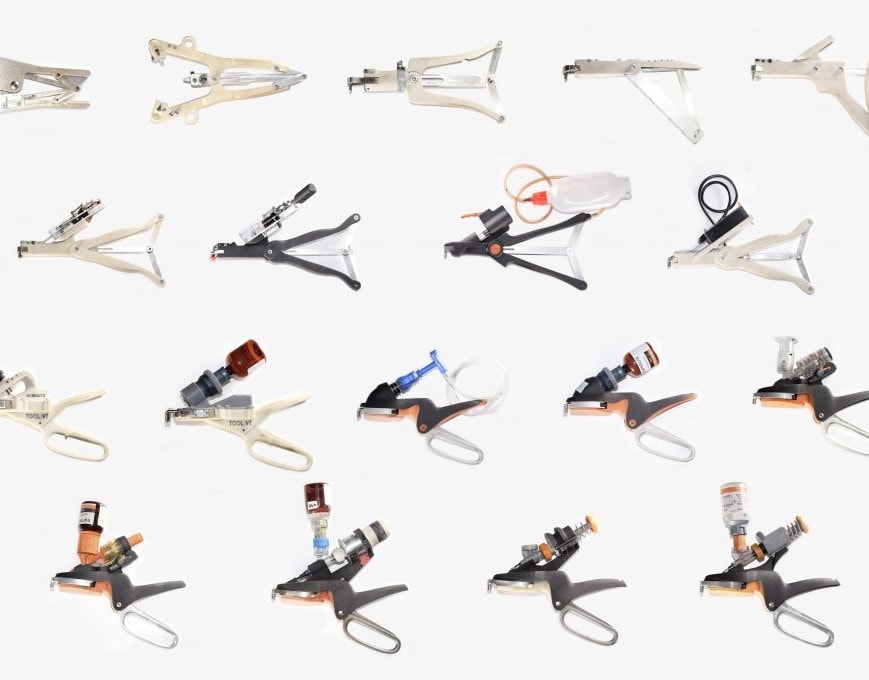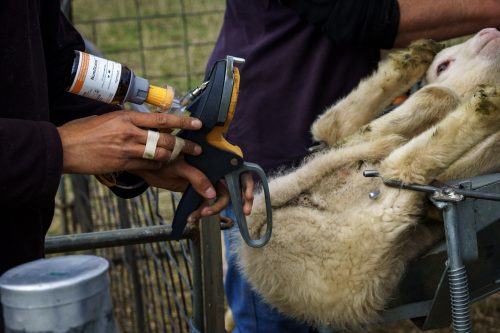This device is designed by engineers to reduce user pain and fatigue
Do you know that using a hand tool can activate up to 42 different hand muscles? That’s what we learned when researching and developing the Numnuts device. We had lengthy discussions and detailed investigations in the design studios, where our engineers were ensuring that the Numnuts device has the best ergonomics for its users’ health and comfort. This was a major part of our R&D and we’re pleased to say that so far, user feedback has been good. .
The problems that tools can cause
When first researching our device, we learned that using pliers to apply elastrator rings can cause some users problems. Repetitive Strain Injury (RSI) is a painful condition arising from repeating even minor actions over and over. In this case, squeezing the pliers against the tension of the ring may be an easy and minor action, yet it’s often accompanied by other rotational movements through the wrist and hands.
Days of repeated actions can lead to RSI in the form of pain, throbbing, tingling or numbness, not only in the hands, but in other areas of the body too. In the long term, this can lead to osteoarthritis.

Why ergonomics matter during lamb marking
Now we know that farmers are a strong breed, but it was important that we consider this. If we didn’t get it right, sheep farmers simply wouldn’t want to use Numnuts – and with good reason. Anyone can be subject to RSI, but it’s even worse for more mature farmers whose hands may be growing weaker with age, or who are developing arthritis. Nobody likes to experience pain at the end of the day, or worse, while working. This meant we wanted to embrace good ergonomic tool design.
The features of an ergonomic tool
Muscle strains and injuries happen in every industry where ongoing tool use is a feature of the working day. Ergonomic hand tools display several features:
- All hand positions and actions are natural for the body to perform.
- Pressure is distributed evenly, so there are no hard pressure points.
- The grip needed isn’t so strong that it makes precision movements with the finger or thumb difficult.
- Spring-loaded mechanisms don’t need to be held under pressure for periods of time.
- Levers are long enough to reduce the force needed to implement the tool.
- The grip is comfortable within the hand, in terms of both shape and material.
- The tool amplifies the effect of small hand actions.

Farmers talked, we listened
Using ergonomic, well-balanced tools reduces all the causes of RSI, making work easier, not harder. We consulted and worked with farmers to find out what worked best for them, and what didn’t. We considered how much the device weighed and how it best balanced in the hand when a full bottle of NumOcaine was added. We had to make sure that this completely manual system was equally easy for left-handed or right-handed users. Could users with small hands use it just as easily? And would its use be affected by very cold or hot environmental temperatures? It was also important to ensure that it could always be used safely.
The ergonomic design of Numnuts
How did we do? After 15 prototypes and considerable on-farm testing, we designed the device so that operation of the three functions – ring application, needle insertion, and delivery of anaesthetic – is smooth, easy, quick and consistently accurate. Here’s how.
1. Applying the ring
When applying the ring using the Numnuts device, the user does not need to twist their wrist. Instead, Numnuts utilises the hands’ natural ‘tennis racket squeeze’ grip, without any wrist rotation.
The handle is initially squeezed hard to open the ring. With traditional pliers (designed in the 1950s), once opened, the spring force is at its greatest. However, with Numnuts, an over-centring mechanism kicks in that vastly reduces the holding pressure needed to keep the ring open. This is a lot easier for the user, no matter their hand size or strength.
There’s no hard gripping or wrist twisting at the stage that requires most dexterity – when the elastrator ring is being positioned over the tail or testicles. At the end, the user rolls their wrist back to release the ring, again, with no twisting involved.

2. Injecting the local anaesthetic
The NumOcaine bottle is placed centrally, improving the user’s line of sight to the injection point.
Once the needle is in position, the user pushes the thumb or palm-operated plunger button, which has a wide rounded top to make it comfortable, to inject and deliver NumOcaine.
The user must have two hands on the device to operate the plunger, meaning there is no risk of needle-stick injury. The needle fully retracts after the injection, to further reduce this risk.

3. Holding the device
The device is ‘ambidextrous’ in that it works in the same way for both right- and left- handed people. The handles are contoured to comfortably fit both larger and smaller sized hands.
There are no palm pressure points from hard rubber or plastic – the materials are soft-feel and comfortable to hold in all weathers.
It’s lightweight, meaning users of all sizes and strengths can operate it easily, all day long.
Simple! We hope you enjoyed this insight into why working with your Numnuts device feels so comfortable!